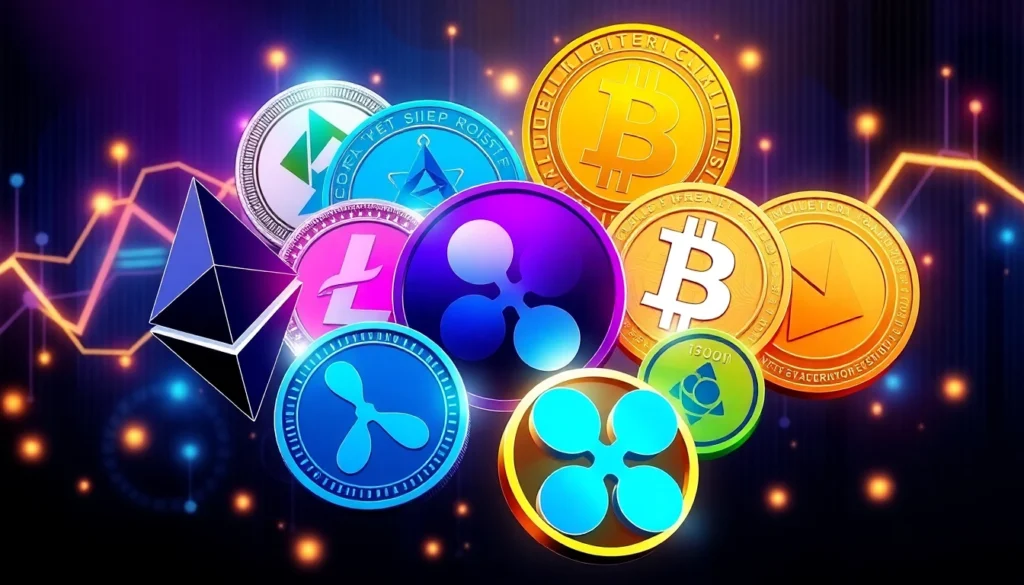Understanding Altcoins: Definitions and Market Overview
In the ever-evolving landscape of cryptocurrencies, altcoins have emerged as significant players that diversify the digital asset ecosystem beyond Bitcoin. These alternative digital currencies encompass a broad spectrum of projects, each with unique features, technological innovations, and investment potentials. Recognizing the distinctions between Bitcoin and altcoins, along with understanding their market history and growth, provides essential insights for investors, developers, and enthusiasts aiming to navigate this dynamic space.
What Are Altcoins and How Do They Differ from Bitcoin
At their core, altcoins are cryptocurrencies launched as alternatives to Bitcoin, often aiming to improve upon its limitations or serve specific use cases. The term “altcoin” is derived from “alternative” and “coin,” collectively describing all cryptocurrencies other than Bitcoin. For example, Ethereum, Litecoin, and Ripple are classic examples of well-established altcoins. While Bitcoin’s primary function is as a decentralized store of value and medium of exchange, many altcoins focus on additional functionalities such as smart contracts, faster transaction speeds, privacy features, or unique consensus mechanisms.
Technically, altcoins differ from Bitcoin in several aspects, including blockchains, algorithms, and purposes. Some, like Ethereum, operate via their native blockchain and have their own ecosystems and developer communities, while others are tokens built on existing platforms like Ethereum or Binance Smart Chain. The strategic variations among altcoins often reflect the specific problems they intend to address in finance, supply chain, gaming, or decentralized finance (DeFi).
Historical Growth and Market Trends of Altcoins
The rise of altcoins dates back to shortly after Bitcoin’s inception in 2009. Early projects like Litecoin (launched in 2011) offered faster transactions and a different hashing algorithm. Over time, the ecosystem diversified exponentially, driven by technological innovation, investor interest, and the democratization of blockchain development tools.
Recent years have witnessed astonishing growth trajectories. For example, tokenized institutional funds (IAFs) surged by 47%, and Dutch firm Amdax raised over $23 million to establish a Bitcoin treasury company, illustrating institutional adoption of altcoin-based strategies. The market capitalization of altcoins now accounts for a substantial proportion of the overall crypto market, with some commodities like Ethereum and Binance Coin (BNB) emerging as integral components of DeFi and NFT ecosystems.
The volatile market cycles have shown periods of explosive growth—commonly referred to as “altseason”—where altcoins outperform Bitcoin significantly. Industry experts anticipate that new technological advancements and macroeconomic shifts will continue to shape these trends, creating new opportunities and challenges for investors and developers alike.
Key Features That Make Altcoins Attractive to Investors
Altcoins attract investors for myriad reasons. Some key features include:
- Innovation and Differentiation: Many altcoins introduce groundbreaking features such as privacy enhancements (e.g., Monero), interoperability (e.g., Polkadot), or scalability solutions (e.g., Solana).
- High Growth Potential: The ability to capitalize on rapid price appreciation during market surges makes altcoins appealing for speculative investors.
- Diversification: Including various altcoins in a portfolio can mitigate risks associated with the dependency on Bitcoin’s market movements, especially given correlations that often fluctuate in different market cycles.
- Utility and Use Cases: Utility tokens underpin decentralized applications, offering governance rights, access to services, or fee discounts, creating intrinsic value.
- Institutional Interest: An increasing number of institutional players are diversifying portfolios by holding large positions in stable and promising altcoins, exemplified by recent multi-million dollar buys and strategic treasury allocations.
Popular Types of Altcoins and Their Use Cases
Utility Tokens and Security Tokens Explained
Within the altcoin universe, two primary categories stand out: utility tokens and security tokens. Understanding their structures and applications is vital for evaluating potential investments.
- Utility Tokens: These are digital assets used within a specific platform or ecosystem to access services, participate in governance, or incentivize behaviors. For instance, Tether’s USD₮ going native on Bitcoin and the recent adoption of RGB for stablecoin integration demonstrate how utility tokens can enhance functionality and interoperability across blockchains.
- Security Tokens: These are tokenized representations of traditional assets such as equities, bonds, or real estate. They’re regulated and often offer compliance with existing financial laws, making them attractive for institutional investors seeking digital security investments.
Emerging Altcoin Projects with High Potential
Several innovative projects are making waves due to their technological promise and strategic backing:
- Layer 2 and Scalability Solutions: Projects like Metaplanet are actively building on Layer 2 chains, aiming to solve scalability issues and facilitate seamless dApp development.
- Blockchain Interoperability: The Ethereum foundation’s focus on interoperability aims to streamline cross-chain communication, essential for expanding the web3 ecosystem.
- Decentralized Finance (DeFi): Platforms like Flare’s XRPFi framework are enabling innovative treasury yield mechanisms for corporations, expanding the utility of altcoins in traditional finance contexts.
How Altcoins Are Enhancing Blockchain Adoption
Beyond speculation, altcoins are crucial enablers for broader blockchain adoption. Their diverse functionalities facilitate real-world applications, from tokenized institutional funds to national governmental proposals for blockchain integration, such as the Philippine senator’s push to put the national budget on the blockchain.
Investing in Altcoins: Strategies and Best Practices
Fundamental Analysis for Altcoin Investment Decisions
Effective investment begins with thorough analysis. Key factors include technological viability, developer activity, adoption rates, and community support. Evaluating Whitepapers, roadmaps, and recent updates on projects like Amdax’s Bitcoin treasury initiatives can offer clues to future performance.
Risk Management and Diversification with Altcoins
Given the high volatility and potential for scams—such as the rise of crypto hacking syndicates in South Korea—risk mitigation strategies like diversification across different projects and asset classes, setting stop-loss orders, and keeping abreast of security best practices are critical.
Timing and Market Indicators for Buying Altcoins
Market sentiment indicators, volume analysis, and macroeconomic factors influence the optimal entry points. Watching for altseason signals, such as rapid ETH, SOL, and BNB growth, can guide strategic buying decisions, especially during periods outlined by industry forecasts of explosive growth.
Future Outlook and Trends in the Altcoin Ecosystem
Impact of Regulatory Changes on Altcoin Markets
As governments worldwide increase regulatory scrutiny—exemplified by South Korea’s crackdown on hacking syndicates and proposed blockchain budget allocations—legal developments will influence market structures and project viability. Clearer frameworks could both stimulate institutional participation and impose restrictions.
Technological Innovations Shaping Altcoin Development
Emerging innovations like cross-chain interoperability, privacy enhancements, and on-chain capital markets are attracting investment and developer interest. Notably, Ethereum’s focus on UX and interoperability promises to streamline user experiences and foster broader adoption.
Predictions for Altcoin Price Movements and Market Cycles
Experts forecast that, driven by institutional backing and technological breakthroughs, select altcoins will experience significant surges, potentially 10-100X in value, especially during upcoming altseason phases. Careful analysis of market cycles, as seen historically, remains essential for capturing these gains.
Tools and Resources to Track and Analyze Altcoins
Top Platforms for Real-Time Altcoin Data
Platforms like CoinMarketCap, CoinGecko, and Binance provide comprehensive, real-time data including price movements, volume, and market capitalization. These tools are vital for timely decision-making and monitoring emerging trends.
Using Analytics and Social Media for Market Insights
Social platforms such as Twitter, Reddit, and Telegram host active communities discussing altcoin developments. Using sentiment analysis tools and following notable industry influencers can provide early signals of market shifts or project milestones.
Developing a Personal Altcoin Investment Plan
A structured plan should incorporate asset allocation based on risk tolerance, diversification, entry/exit strategies, and security measures like cold wallets or hardware devices. Continuous education through tutorials, webinars, and news updates enhances decision-making confidence.


